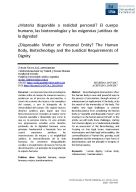Por favor, use este identificador para citar o enlazar este ítem:
https://repositorio.uca.edu.ar/handle/123456789/8322| Campo DC | Valor | Lengua/Idioma |
|---|---|---|
| dc.contributor.author | Lafferrière, Jorge Nicolás | es |
| dc.date.accessioned | 2019-07-03T16:21:42Z | - |
| dc.date.available | 2019-07-03T16:21:42Z | - |
| dc.date.issued | 2018 | - |
| dc.identifier.citation | Lafferrière, J. N. (2018). ¿Materia disponible o realidad personal? : el cuerpo humano, las biotecnologías y las exigencias jurídicas de la dignidad [en línea]. Sociología y Tecnociencia, 8(1). Disponible en: https://repositorio.uca.edu.ar/handle/123456789/8322 | es |
| dc.identifier.issn | 1989-8487 | - |
| dc.identifier.uri | https://repositorio.uca.edu.ar/handle/123456789/8322 | - |
| dc.description.abstract | Resumen: Las intervenciones biotecnológicas inciden sobre el cuerpo de maneras nuevas y poderosas en el proceso de procreación, a través de acciones de mejora o de reemplazo del cuerpo, o por la búsqueda de la inmortalidad del cuerpo. Ello supone nuevos desafíos jurídicos para lograr que esta biotecnociencia no considere al cuerpo como material operable y disponible sino como lo que es, la persona misma. En este artículo nos proponemos estudiar estos desafíos partiendo de la dignidad humana como principio fundamental y haciendo foco en cuatro cuestiones jurídicas: las intervenciones de mejora y su exigibilidad jurídica; la mercantilización de la vida humana; las crecientes desigualdades sociales y el surgimiento de nuevas formas de discriminación; y el principio de integridad de la especie humana. | es |
| dc.description.abstract | Abstract: Biotechnological interventions affect the human body in new and powerful ways in the process of procreation, through actions of enhancement or replacement of the body, or by the search of the immortality of the body. This implies new legal challenges to prevent biotechnoscience from considering the human body as "operable and disposable matter", and treating it as the human person himself. In this article, we will study these challenges, starting from human dignity as a fundamental principle for an assessment of this biotechnology, and focusing on four legal issues: improvement interventions and their legal enforceability; the commodification of human life; growing social inequalities and the emergence of new forms of discrimination; and the principle of integrity of the human species. | es |
| dc.format | application/pdf | es |
| dc.language.iso | spa | es |
| dc.publisher | Universidad de Valladolid | es |
| dc.rights | Acceso Abierto | es |
| dc.rights.uri | https://creativecommons.org/licenses/by-nc-sa/4.0/ | es |
| dc.source | Sociología y Tecnociencia, 8(1), 2018 | es |
| dc.source | ISSN 1989-8487 | es |
| dc.subject | DERECHO | es |
| dc.subject | CUERPO HUMANO | es |
| dc.subject | DIGNIDAD HUMANA | es |
| dc.subject | BIOETICA | es |
| dc.subject | BIOTECNOLOGIA | es |
| dc.subject | FILOSOFIA DE LA CIENCIA | es |
| dc.subject | PROCREACION | es |
| dc.subject | BIODERECHO | es |
| dc.title | ¿Materia disponible o realidad personal? : el cuerpo humano, las biotecnologías y las exigencias jurídicas de la dignidad | es |
| dc.title | ¿Disposable matter or personal entity? : the human body, biotechnology and the juridical requirements of dignity | es |
| dc.type | Artículo | es |
| uca.path | Facultad de Derecho|Artículos | es |
| uca.disciplina | DERECHO | es |
| uca.filename | /home/data-uca-generic/folder_facultad/varios/materia-disponible-realidad-personal/metadata.xml | es |
| uca.issnrd | 1 | es |
| uca.affiliation | Fil: Lafferrière, Jorge Nicolás. Pontificia Universidad Católica Argentina. Facultad de Derecho. Cátedra Internacional Ley Natural y Persona Humana; Argentina | es |
| uca.version | publishedVersion | es |
| item.grantfulltext | open | - |
| item.fulltext | With Fulltext | - |
| item.languageiso639-1 | es | - |
| crisitem.author.dept | Facultad de Derecho | - |
| crisitem.author.dept | Programa IUS | - |
| crisitem.author.dept | Centro Santa Teresa de Calcuta | - |
| crisitem.author.orcid | 0000-0003-2600-2226 | - |
| crisitem.author.parentorg | Pontificia Universidad Católica Argentina | - |
| crisitem.author.parentorg | Facultad de Derecho | - |
| crisitem.author.parentorg | Facultad de Derecho | - |
| Aparece en las colecciones: | Artículos | |
Ficheros en este ítem:
| Fichero | Descripción | Tamaño | Formato | |
|---|---|---|---|---|
| materia-disponible-realidad-personal.pdf | 280,55 kB | Adobe PDF |  Visualizar/Abrir |
Visualizaciones de página(s)
386
comprobado en 30-abr-2024
Descarga(s)
290
comprobado en 30-abr-2024
Google ScholarTM
Ver en Google Scholar
Este ítem está sujeto a una Licencia Creative Commons

